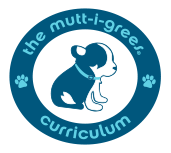Instincts guide many dog behaviors; instincts are natural behaviors that a dog is born with. For example, dogs don’t need to learn how to dig – they are born knowing how to do it! Instincts help animals survive. Dogs instinctively guard their food and their space to protect it. When we know that instinctively dogs guard their food, what does it tell us? It tells us we should not approach or try to play with a dog while he is eating. How would the dog react? Although dogs are born with some of these instinctual behaviors, other behaviors are learned; a dog’s parents or pack members can teach them behaviors, some of which are based on rules. Can you think of a behavior that your dog or a dog you know has learned? People also have instincts, and like animals, many of our instincts help us to survive. It’s important to pause and take a moment to think about what our instincts are telling us, and why.
- Let’s think of some things dogs might do every day (i.e., eat, growl, play with a toy). Which of these behaviors are based on instinct and which are learned behaviors?
- Now let’s think of some things we do every day (i.e., eat breakfast, walk downstairs, play, brush teeth, raise hand in class). Which of these behaviors are based on instinct and which are learned behaviors?
Objective:
Children will learn about instincts, both animal and human, and how they guide behavior. Children will also begin to consider the difference between learned behavior and instinctual behavior. An awareness of the instinctual world of dogs is prerequisite to effective and compassionate interactions with dogs, and it connects us with nature. Is also supports the whole child, holistic approach to education, which focuses not only on the intellect and academics, but on creating connections between the mind, heart and body – it is through these connections that we achieve a balance in life.
Vocabulary Words to Highlight:
Instinct, Survive, Learned, React, Mind-Heart-Body Connections

